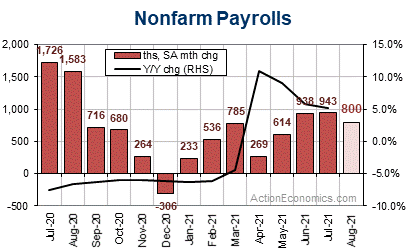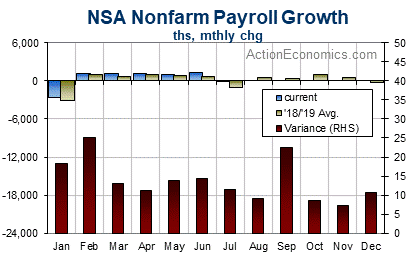All eyes are now on the August jobs report, as if they weren’t already. After Powell reiterated the policy path will largely depend on the data and warned some numbers might not be as robust due to the spread of the Delta variant and ongoing mismatches of supply and demand, the August jobs report was brought into clear focus.
Fed Chair Powell left the door wide open for the Fed to start reducing asset purchases this year. He still sees “substantial slack remaining in the labor market and the pandemic continuing” and he worries that an “ill-timed” policy mistake could be “particularly harmful.” The Chair indicated the conflicting factors too, which we see as keeping the Fed on hold for now: we have seen “more progress in the form of a strong employment report for July, but also the further spread of the Delta variant. We will be carefully assessing incoming data and the evolving risks.” Amid the wait for Friday’s jobs report, today’s US markets are little changed with Treasuries fractionally weaker after the Powell rally ran out of steam.
August nonfarm payroll estimate sits at 800k, versus July’s 943k rise. The gain is consistent with our 7.0% Q3 GDP growth estimate, assuming an August workweek of 34.8 that leaves a solid 0.6% August rise for hours-worked, alongside a 0.3% hourly earnings gain that extends a 0.4% July rise, and a jobless rate drop to 5.2% from 5.4%. Claims data continue to tighten and producer sentiment remains robust despite some easing, though most consumer confidence measures have continued to fall from Q2 peaks.

The 800k nonfarm payroll forecast assumes a 700k private jobs increase. The goods based employment increase is pegged at 60k, after a 44k increase in July. Construction employment is seen rising 20k after 11k in July and a -5k dip in June, while factory jobs rise 35k, after a 27k increase in July, and a 39k increase in June. We assume a private service job increase of 690k in August, after a 659k increase in July. We expect a 50k increase in government employment, with an August lift from the seasonal factors for education.
Seasonal Trends and Weather
The graph below shows the two-year average NSA payroll change for each month, pre-2020. The seasonal impact through the year on payroll changes is mostly positive, but is negative in December, January and July. Distortions of last year’s COVID-19 would have produced negative averages for March and April as well. The ’18/’19 NSA average rebounded to 453k in August from -1,111k in July, and 644k in June. The red bars show each month’s variance. After a first-half peak in February, variance decreases over the spring before reaching a second-half peak in September.

For disruptions to employment from weather as gauged in the household survey, the biggest disruptions occur in the winter months generally with the average peaking in February. There is an additional climb through the late-summer months in years when there are disruptive hurricanes. The ten-year average number of people not working as a result of weather rises to 31k in August from 10k in July, 24k in June, and 42k in May.
Click here to access our Economic Calendar
Andria Pichidi
Market Analyst
Disclaimer: This material is provided as a general marketing communication for information purposes only and does not constitute an independent investment research. Nothing in this communication contains, or should be considered as containing, an investment advice or an investment recommendation or a solicitation for the purpose of buying or selling of any financial instrument. All information provided is gathered from reputable sources and any information containing an indication of past performance is not a guarantee or reliable indicator of future performance. Users acknowledge that any investment in Leveraged Products is characterized by a certain degree of uncertainty and that any investment of this nature involves a high level of risk for which the users are solely responsible and liable. We assume no liability for any loss arising from any investment made based on the information provided in this communication. This communication must not be reproduced or further distributed without our prior written permission.



















